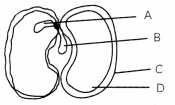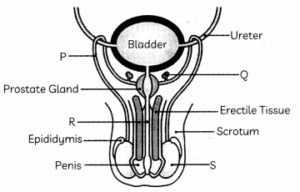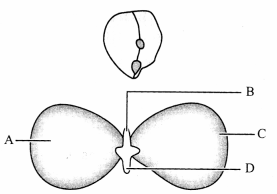How do Organisms Reproduce? Class 10 MCQs Questions with Answers
Question 1.
Fertilisation is the process of:
(a) transfer of male gamete to female gamete.
(b) fusion of nuclei of male and female gamete.
(c) adhesion of male and female reproductive organs.
(d) the formation of gametes by a reproductive organ.
Answer:
(b) Fusion of nuclei of male and female gamete.
Explanation: Fertilization is the fusion of nucleus of male and female garnets to form a single cell called as zygote. Fertilization occurs in sexually reproducing organisms.
Related Theory:
During sexual mode of reproduction germ cells (gametes) of two individuals need to fuse together. It can happen by either of the following:
External release of germ cells from body of an individual as seen in angiospermic plants, frog, fish etc. This is known as external fertilization.
Internal transfer of germ cells by physical contact between male and female organisms as in mammals. This is called internal fertilization.
Question 2.
Characters that are transmitted from parents to offsprings during reproduction show:
(a) OnLy similarities with parents
(b) Only variations with parents
(c) Both similarities and variations with parents
(d) Neither similarities nor variations
Answer:
Question 3.
Choose the correct statement(s) on budding in yeast from the foLlowing:
(I) A parent celL divides into two or more daughter ceLLs and here the parent identity is Lost.
(II) In this the eLongated nucLeus divides to form two or more daughter nucLei.
(III)A bud arises from a particuLar region on a parent body.
(IV)After detaching from the parent body the bud grows into a new independent individual.
(a) (I) only
(b) (III) only
(c) (II) and (III) only
(d) (III) and (IV) only
Answer:
(d) (III) and (IV) only
Explanation: Yeast reproduces asexually by the process of budding in which a bud arises from a particular region on a parent body. And after detaching from the parent body the bud grows into a new independent individual.
Statements I and II are for binary and multiple fission respectively.
Question 4.
The number of chromosomes in parents and offsprings of a particular species remains constant due to:
(a) Doubling of chromosomes after zygote formation
(b) Halving of chromosomes during gamete formation
(c) Doubling of chromosomes after gamete formation
(d) Halving of chromosomes after gamete formation
Answer:
Question 5.
In the following figure, different stages of binary fission in amoeba are depicted, which are not in the proper sequence
Answer:

The correct sequence is
(a) (II), (III), (IV), (I) (b) (I), (II), (IV), (III)
(c) (III), (IV), (II), (I) (d) (I), (III), (IV), (II)
[CBSE 2017]
Ans. (a) (II), (III), (IV), (I)
Explanation: The correct sequence of the different stages of binary fission in amoeba is:
(II) Parent amoeba cell.
(III) Duplication of the genetic material and elongation of the nucleus.
(IV) Nuclear division and constriction in cytoplasm
(I) Formation of two daughter amoeba cells.
Question 6.
In Rhizopus, tubular thread-like structures bearing sporangia at their tips are called:
(a) Filaments
(b) Hyphae
(c) Rhizoids
(d) Roots
Answer:
Question 7.
Select the correct statements for the process of budding in yeast:
(I) A bud arises from a particular region on a parent body.
(II) A parent cell divides into two daughter cells, here the parent identity is lost.
(III) Before detaching from the parent body a bud may form another bud.
(IV) A bud when detaches from the parent body grows into a new individual.
(a) (I), (II) and (III)
(b) (II), (III) and (IV)
(c) (III), (IV) and (I)
(d) (IV), (I) and (II)
Answer:
Question 8.
Slides of binary fission in Amoeba and budding in yeast were given for observation to a group of students. Some of the observations reported by the group are given below:
(I) Cytokinesis was observed in the yeast cell.
(II) A chain of buds were observed in Amoeba.
(III) Single cell of Amoeba and single cell of yeast were undergoing binary fission and budding respectively.
(IV) Elongated nucleus was dividing to form two daughter nuclei in Amoeba.
The correctly reported observations are:
(a) (I) and (II)
(b) (II) and (III)
(c) (III) and (IV)
(d) (I) and (IV)
Answer:
(c) (III) and (IV)
Question 9.
Which of the following statements are true for flowers?
(I) Flowers are always bisexual
(II) They are the sexual reproductive organs
(III) They are produced in all groups of plants
(IV) After fertilization they give rise to fruits
(a) (I) and (IV)
(b) (II) and (III)
(c) (I) and (III)
(d) (II) and (IV)
Answer:
(d) (II) and (IV) i.e. they are the sexual reproductive organs and after fertilization they give rise to fruits
Explanation: Flowers are the sexually reproductive organs of a plant and a fertilized flower give rise to fruit.
Question 10.
During adolescence, several changes occur in the human body. Mark one change from the following associated with sexual maturation in boys:
(a) loss of milk teeth
(b) increase in height
(c) cracking of voice
(d) weight gain
Answer:
Question 11.
Which among the following statements are true for sexual reproduction in flowering plants?
(I) It requires two types of gametes.
(II) Fertilisation is a compulsory event.
(III) It always results in the formation of zygote.
(IV) Offsprings formed are clones.
(a) (I) and (IV)
(b) (I), (II) and (IV)
(c) (I), (II) and (III)
(d) (I), (II) and (III)
Answer:
Question 12.
Characters transmitted from parents to offspring are present in:
(a) Cytoplasm
(b) Ribosome
(c) Golgi bodies
(d) Genes
Answer:
(d) Genes
Explanation: Genes are the unit of heredity DNA that determine genetic characters in an organism.
Question 13.
Semen which contains millions of sperms also contains secretions of seminal vesicle and prostrate gland (accessory glands). It makes the tranport of sperms easier and provide nutrition to sperms.
Correct sequence of organs in the male reproductive system for transport of sperms is:
(a) Testis → vas deferens → urethra
(b) Testis → ureter → urethra
(c) Testis → urethra → ureter
(d) Testis → vas deferens → ureter
Answer:
(a) Testis → vas deferens → urethra
Explanation: Testis produces sperms or germ cells. The sperms formed are delivered through the vas deferens which unites with a tube coming from the urinary bladder. The urethra thus forms a common passage for both the sperms and urine.
Question 14.
Reproduction is essential for living organisms to order to:
(a) Keep the individual organism alive
(b) Fulfill their energy requirements
(c) Maintain growth
(d) Continue the species generation after generation
Answer:
Question 15.
Which one of the following permanently marks the end of menstrual cycle in females?
(a) Menarche
(b) Menopause
(c) Ovulation
(d) Pregnacy
Answer:
Question 16.
Which among the following diseases is not sexually transmitted?
(a) Syphillis
(b) Hepatitis
(c) HIV-AIDS
(d) Gonorrhoea
Answer:
(b) Hepatitis
Explanation: Hepatitis is not a sexually transmitted disease. It is a water-borne viral disease.
Question 17.
The sketch of a dicotyledonous seed is shown below.

The correct labelling for parts A, B, C and D iri proper sequence is
(a) radicle, plumule, cotyledon, seed coat.
(b) radicle, plumule, seed coat, cotyledon.
(c) plumule, radicle, cotyledon, seed coat.
(d) plumule, radicle, seed coat, cotyledon
Answer:
Question 18.
Which of the following is not the part of female reproductive system?
(a) ovary
(b) fallopian tube
(c) uterus
(d) vas deferens
Answer:
(d) vas deferens
Explanation: Vas deferens is part of male reproductive system.
Question 19.
Select the statements that are incorrect about reproduction in human beings.
(I) When a girl is born, the ovaries already contain thousands of mature eggs.
(II) One egg is produced every month by one of the ovaries.
(III) The egg is carried from the ovary to the womb through oviduct.
(IV) The two oviducts unite into an elastic bag-like structure known as the cervix.
(a) Both (I) and (III)
(b) Both (I) and (IV)
(c) Both (II) and (III)
(d) Both (II) and (IV)
Answer:
Question 20.
Study the diagram given below of male reproductive organ and select the row containing incorrect information.

| Name of Part | Function |
| (a) P is Vas deferens | Transport sperms |
| (b) Q is Seminal vesicle | Provide fluid medium to sperms |
| (c) R is ureter | Passage for sperms |
| (d) S is Testis | Formation of sperms |
Answer:
Question 21.
Study the figure below and identify the row containing incorrect information.

| Part Name | Function |
| (a) A is Cotyledon | It is the future plant |
| (b) B is Plumule | It is the future shoot |
| (c) C is Seed coat | It is the outer covering of the ovule |
| (d) D is Radicle | It is the future root |
Answer:
(a) Part Name: A is cotyledon; Function: It is the future plant
Explanation: A is cotyledon and is the food store of the future plant.
Question 22.
Study the figure showing parts of a flower and identify the correct statements.
(I) Part labelled 1 is the pollen grain and contains the male germ cell.
(II) Part labelled 3 is the stigma on which the pollen grains land.
(III) The male germ cell travels through the pollen tube (part labelled 3) after fertilization.
(IV) Part labelled 4 is the ovary which contains the female germ cells.
(a) Both (I) and (III)
(b) Both (II) and (IV)
(c) Both (I) and (III)
(d) Both (I) and (IV)
Answer:
Question 23.
Identify the incorrect statement from among the following statements for unisexual flowers.
(a) They always possess stamen and pistil
(b) They possess either stamen or pistil
(c) They show cross pollination
(d) Unisexualflowers posessing only stamens cannot produce fruits
Answer:
(a) They always possess stamen and pistil
Explanation: Unisexual flowers contain either stamens or carpels. Bisexual flowers contain both male and female reproductive organs stamen and carpel.
Question 24.
The part where fertilization occurs in human females is:
(a) cervix
(b) vagina
(c) uterus
(d) oviduct
Question 25.
The table below lists the organs/parts of human reproductive system and their functions. Identify the row containing incorrect information.
| Part/ Organ of Reproductive system | Function |
| (a) Prostate gland and seminal vesicles | Production of fluid to provide a medium for sperms. |
| (b) Testis | Secretes the hormone that regulates formation of sperms. |
| (c) Uterus | Provides nutrition from mother’s blood to embryo. |
| (d) Fallopian tube | Carries egg from ovaries to the womb |
Answer:
(c) Part/Organ of Reproductive system: Uterus; Function: Provides nutrition from mother’s blood to embryo.
Explanation: The embryo gets nutrition from the mother’s blood with the help of a special tissue called placenta which is a disc embedded in the uterine wall and contains villi on the embryo’s side of the tissue.
Assertion Reasoning questions Class 10 Science Chapter 8
For the following questions two statements are given-one labeled Assertion (A) and the other labeled Reason (R). Select the correct answer to these questions from the codes (a), (b), (c) and (d) as given below:
(a) Both (A) and (R) are true and (R) is correct explanation of the assertion.
(b) Both (A) and (R) are true but (R) is not the correct explanation of the assertion.
(c) (A) is true but (R) is false.
(d) (A) is false but (R) is true.
Question 26.
Assertion (A): Variation is useful for the survival of species over time.
Reason (R): Populations of organisms fill well-defined places in the ecosystem, using their ability to reproduce.
Answer:
(b) Both (A) and (R) are true but (R) is not the correct explanation of the assertion.
Explanation: Although populations of organisms fill well-defined pLaces in the ecosystem, using their ability to reproduce, the consistency of DNA copying during reproduction. Reproduction is important for the maintenance of body design features. Reproduction is linked to the stability of populations of species.
However, variation is useful for the survival of species over time as niches can change drastically but only those organisms will be able to survive which have some variations in them.
Question 27.
Assertion (A): All multi-cellular organisms can divide cell by cell.
Reason (R): Many multi-cellular organisms are not simply a random collection of cells.
Answer:
(d) (A) is false but (R) is true
Explanation: All multi-cellular organisms cannot simply multiply cell by cell as they are not just a random collection of cells. Specialized cells are organized as tissues and tissues are organized into organs, which occupy definite positions in the body. Multi-cellular organisms, therefore, need to use more complex ways of reproduction.
Question 28.
Assertion (A): Vegetative propagation makes possible propagation of plants that have lost the capacity to produce seeds.
Reason (R): New plants are developed from seeds in vegetative propagation.
Question 29.
Assertion (A): Pollen grains are produced by all flowers.
Reason (R): Stamen is the male reproductive part of a flower and produces pollen grains.
Answer:
(d) (A) is false but (R) is true
Explanation: All flowers do not produce pollen grains as flowers may be unisexual when it contains either stamens or pistil or bisexual when it contains both stamens and pistil. Stamen is the male reproductive part of a flower and produces pollen grains that are yellowish in colour.
Question 30.
Assertion (A): Testes in human males are located outside the abdominal cavity in scrotum.
Reason (R): Testes secrete the male sex hormone testosterone.
Answer:
(b) Both (A) and (R) are true but (R) is not the correct explanation of the (A)
Explanation: The testes in human males are located outside the abdominal cavity in the scrotum as sperm formation requires a lower temperature than the normal body temperature. Testes secrete the male sex hormone testosterone which regulates the formation of sperms and brings about changes in appearance seen in boys at the time of puberty.
Question 31.
Assertion (A): The human embryo gets implanted in the fallopian tube.
Reason (R): Embryo gets nutrition from the mother’s blood with the help of special tissue called the Placenta.
Question 32.
Assertion (A): A basic event in reproduction is the creation of a DNA copy.
Reason (R): The DNA in the cell nucleus is the information source for making proteins.